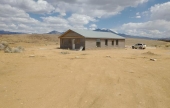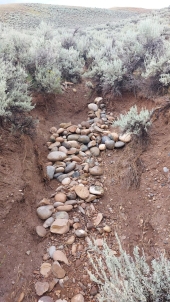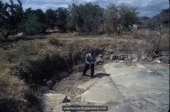







shauna carr wrote:Congrats on your project, it looks like it'll be a lot of fun!
So, most of the info I have that might be of use involves smaller specifics and might be more along the lines of 'might be good to research,' but I hope it can help!
First thing: the saguaros. I would highly recommend that you do not dig in around the saguaros if you can help it, if you want them to survive and thrive. They have a very wide root spread - the roots spread out from the cactus for the same number of feet as their height, in all directions (so a 50 foot cactus has a 100 foot diameter total root spread), but it's only a few inches deep - usually 3-5 inches or so.
And the root system has nearly as slow a growth as the saguaro itself, so if the roots are damaged, it takes an incredibly long time for them to come back. A 4 foot cactus' 8 foot root system usually takes about 55 years to grow, for example. So the cactus will have to cannibalize its own internal supplies to try and survive while its roots recovers, if they are damaged. And as we are in a huge mega drought, and may be for a number of years, this could be disastrous for the saguaro, you know?
...as an aside, this is why so many saguaros in cities, with little to no space around them to grow roots, are sickly and dying. Modern landscaping is honestly terrible for saguaros. :-/
re: food production. Are you irrigating, or planning to have any gray water? If you are not, you may want to explore whatever information is out there about...I don't know what the official term would be for this, but basically, at what heat, and at what rainfall level, various plants will stop producing.
I've run into this problem with a lot of desert permaculture plant suggestions before. I get lots of suggestions for what plants will survive a desert climate, but that is NOT the same thing as what plants will still produce food in the same climate. If there is not enough water, your plants will sacrifice making seeds for survival, for the perennials.
Heat can be an issue as well, if you are bringing in any non-native plants - even with shade, some desert plants may struggle with the temperatures + low humidity you are getting out in west Phoenix, if they aren't from a desert that is quite that hot, you know?
re: birds that eat insects - While providing food sources to attract birds sounds good, I would also consider nesting areas and especially shade if you want to attract birds to help keep insects down, as well as a water source if you can manage it, because the drought plus the rising heat, and its impact on plant growth and food sources, is quite literally killing them in AZ.
Small birds have a much lower heat tolerance than we do - the rising temperatures are more dangerous for them. So they were already struggling BEFORE the fire. But with a fire in your area, it's obviously killed off a lot of of the plant life that provided shade and nesting, not to mention food. So they will likely need more support than they might in a typical permaculture site, especially if they have to travel a ways to GET to your site, if the area around you is burnt and doesn't have as much to support them.
(a few brief news stories on the heat and drought problem for birds in AZ- https://www.forbes.com/sites/grrlscientist/2017/02/28/extreme-heat-threatens-desert-songbirds-with-death-by-dehydration/?sh=6fd540452d26
https://www.12news.com/article/tech/science/environment/mass-die-off-of-hundreds-thousands-songbirds-dead-in-arizona-us-southwest-caused-by-due-to-climate-change-issues/75-cc970585-336e-4852-b447-142c43a6abf0 )
re: the grasshoppers. You mentioned " I heard they only eat plants that are weak, lacking nutrients/ soil life or ph is off. "
Soooo...this information is kind of one of those 'in regular circumstances, this would be true' kind of things.
You aren't in regular circumstances though. One thing I think it's really good to remember is that it's not just your plants that suffered from a pretty devastating fire - every other living thing in that area is dealing with it as well. Your area's entire ecosystem is going to be out of wack.
This is going to be a pretty unique situation, in terms of what your site is going to experience. Before, it was a permaculture site in an area that had a working ecosystem that your site would have...kind of just plugged right into and used, you know? But now, you don't. The fire trashed it. It's...it's kind of like moving into a house in a city, vs. moving into a house in a city that just survived a hurricane and has no working infrastructure back up yet.
It can be done, but I guess what I'd say is that your project may be more impacted by this than is obvious at first glance. There may be a lot of situations you run into that aren't going to follow what most permaculture sites are dealing with, which may mean that for conventional wisdom, 'mileage may vary,' as it were.
For example, anything that eats/needs plant matter - leaves, bark, roots, seeds, pollen, you name it - may be dead and gone or could be desperate and potentially on the verge of starvation because their food is, as you noted in how much was burned on your property, GONE. These critters are not just going to eat weak plants; they are going to eat everything, And if you plant a lot of plants, and the area around you is still devastated from the fire? Well, it's going to be like the plant version of the Field of Dreams: if you plant it, they will come.
And the predators of these plant eating critters ALSO got decimated by the fire. They may be too small in number to keep the grasshopper population down at this point.
Or something needed for them to survive/have babies/thrive in your area may no longer exist due to the fire, so they might be living in other areas until your area can support them again and they come back.
So basically, dealing with how messed up the fire has left everything is likely going to be an ongoing issue, because it's going to be added on to the mega drought that was already stressing the animals and plants, plus it's a desert, so it takes animals and plants longer to come back from stressors already.
So for example, exploring what pollinators are still around may be a good idea. Like, most of our local bees are ground dwelling - how many of them can live through fires? How far do the local bees travel to find pollination sources and is that far enough away that the fire would have still impacted them so you won't be getting local bees for a while? How were bat habitats affected in your area and how will that impact pollination? How were butterflies and moths impacted by the fire? How is the local bird population after the fire - did it hit during nesting season, for example?
I have no idea what the answer to these questions is, obviously, but...yeah, I think it may be really helpful for you to explore that so you know what difficulties you may be facing. They are going to be really distinct, but honestly, I would think that the information you get from this process could be really valuable for others who might be trying to help areas that are also devastated by fires and other natural disasters.
Oh, and re: pests as well - one thing that may be good to look out for is what trees/bushes you want to put in and how drought stressors impact your plants' natural protections (or impact the critters that provide some protections).
This was an issue in New Mexico about 10-15 years ago and is still a problem. The Pinyon pine there has a bark-beetle that can be a problem, but like with the grasshoppers, typically it was considered to only be a problem with unhealthy trees. However, the defenses healthy trees have to keep the beetle away turned out to be highly impacted by severe drought, and so when the drought started getting really bad in NM, the beetles absolutely decimated the pinyon pine population across the state. Between 40%-80% of the trees died, depending on the area.
And goodness, rereading my post, gotta say sorry; this post comes off a bit doom-and-gloom. I know it's more 'look out for' than 'this is good to try.' Let's just say that I have a lot more 'oops, screwed THAT up' experiences, so I know a lot of what NOT to do, or what to be worried about, and less of what TO do, sometimes.
Good luck with the site, and I look forward to seeing how it's going!!

Cj Costa wrote:Wow I'm impressed. What are you going to do about watering the trees if it doesn't rain. I'm in Arizona too and we get rain maybe 4 times a year. I dont count sprinkles. lol Does your area get more rain then that?
I would love to see an update in the summer.
thanks for sharing


Skyler Weber wrote:Good to hear they are helping. Did you say 4-5 feet? Did you mean inches? Also are they supporting trees? Also what distance between swales.
As to whether water goes through limestone, the technical answer is yes since water seepage created Carlsbad Caverns. But, it will happen so slowly that the water won't be available to your plants. However, I read about a Zimbabwean farmer (Zephaniah Phiri Maseko) who starts his first swale with the depth all the way down to bed rock.